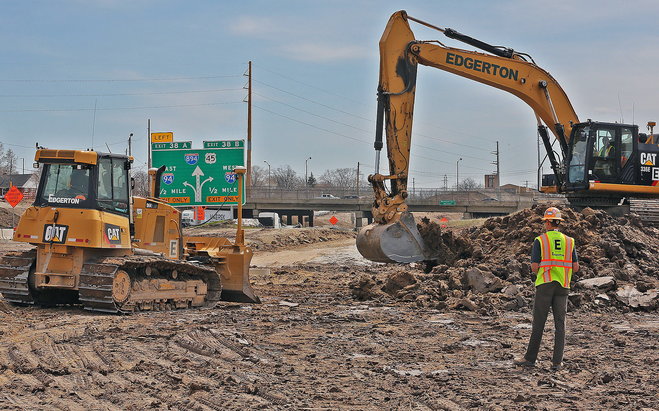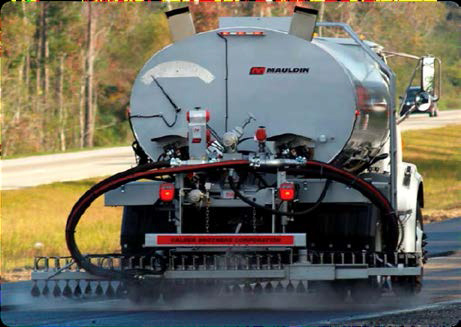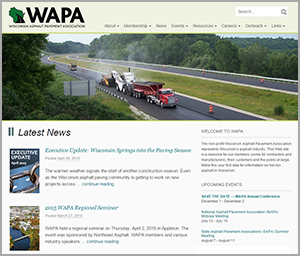
The theme of the midyear National Asphalt Pavement Association meeting, “Peak Performance,” also describes the efforts of the asphalt and transportation communities here in Wisconsin. Even as agency and industry staff are busy building asphalt pavements across the state, work goes on to secure vital transportation funding and to keep designing the highest quality product. These are all necessary ingredients to deliver pavements that perform at their peak and will meet Wisconsin’s needs for years to come.

These are uncertain times for transportation funding in Wisconsin, and the stakes are high. Setting politics aside as much as possible, it is clear that solutions must be found to secure our state’s infrastructure investment. Two recent editorials from Wisconsin newspapers make a strong case for finding creative funding solutions rather than relying solely on long-term borrowing.

The piece paints a vivid picture: “Unless new sources of sustainable revenue are found to pay for maintenance and building, commerce could well choke on the potholes, crumbling pavement and weakened bridges that will become the hallmark of Wisconsin roadways.”
The editorial presents a solution as well: “The state should cut back on some projects, consider raising the gas tax and registration fees in the short-term and consider some method of charging for vehicle miles traveled or toll roads (which would require federal approval) in the long term.”
A road compromise should include raised taxes or fees, Racine Journal Times, June 10, 2015.
This editorial expanded on the virtues of WisDOT Secretary Mark Gottlieb’s transportation funding proposal, a “package that consisted of adjusting the gas tax as well as innovative ways to raise sustainable revenue.”
It points out the shortsightedness of resisting all fee increases: “No one wants to pay any more taxes. But if we borrow more now we are going to have to pay more in the future and that will come in the form of some other new tax increase.
“It’s better to bring in revenue now to pay our bills than to leave it to future generations like the federal government does.”
Emphasizing the local funding message, Transportation Development Association (TDA) of Wisconsin organized the 2015 Drive-In in Madison held on May 6. The Drive-In agenda [PDF] provided an opportunity for Wisconsin stakeholders to hear from elected leaders from both parties, including Assembly Speaker Robin Vos, State Senator Julie Lassa and Representatives Peter Barca and Kathy Bernier. Attendees in turn voiced their own perspectives and shared the need for bold leadership and sound transportation investment. WAPA also delivered transportation funding information to members of Wisconsin’s Joint Finance Committee.
The Drive-In also included a panel of representatives of tourism, agriculture and construction. Their viewpoints on the importance of a robust transportation system and how it affects a wide range of industries were important for all to hear.


The goals of the workshop, as outlined in the workshop flier [PDF], were to enable participants to:
- Identify best practices for constructing tack coats.
- List strategies that could be employed by agency decision-makers to improve the usage of tack coats.
- Identify resources for implementing best practices into standard practice.
Topics included the importance of tack coats; common tack coat grades; new materials; application rate and temperatures; field-testing; tack coat specifications; construction best practices; and surface preparation and traffic control.
WAPA had an opportunity to sit down with presenters the day before the workshop and provide direction on needs and requirements specific to Wisconsin. A technical session at the 2014 WAPA conference addressed Tack Coat Field Performance [PDF] and discussed new specifications [PDF] for increased tack coat—more than double the older requirements. This workshop was an ideal forum to continue to get the word out about Wisconsin developments and best practices.
We would also like to take this opportunity to thank WisDOT for including WAPA in this event. This was yet another show of WisDOT’s outstanding support of public-private cooperation.

The national asphalt industry invests in research to confirm with science the widely held belief that pavement smoothness makes a difference—and that no pavement is as smooth as asphalt.
Representatives of the National Center for Asphalt Technology (NCAT) and NAPA jointly presented a webinar on the outcome of a recent research effort: Effects of Pavement Properties on Vehicular Rolling Resistance.
The research addresses how pavements influence fuel economy and synthesizes existing literature in this area (NCAT’s research report [PDF] details the findings).
This work dovetails with the Asphalt Pavement Alliance’s Smoother Paving—Bigger Savings campaign and fact sheet [PDF]. Some noteworthy items drive home the case for asphalt:

- Smooth roads can result in a 9 percent increase in pavement life.
- Nearly 8 of 10 pavement engineers and DOT officials say asphalt provides the smoothest pavement.
- Pavement smoothness could save up to $73.5 billion in maintenance and repair costs and $340 million in tire wear costs annually in the United States.
- Smoother pavements lead to 4.5 percent lower fuel consumption. That’s about 13 cents per gallon.
The facts speak volumes: Asphalt is the smooth choice, and smoothness matters.


If you have questions or comments about what’s happening among NAPA or the committees (such as Health and Safety, Pavement Economics, and Communications), be sure to let us know ahead of time.
The midyear meeting also features presentation of NAPA’s annual Operational Excellence Awards, and I’m pleased to report that WAPA’s redesigned website is one of three finalists for the Outstanding Website Award. We rebuilt the website with the needs of our members and partners in mind, and it’s rewarding to see that it resonates as a resource and communication tool on a national level as well.

As a parting note, I’d like to pique your interest in a new WAPA publication coming later this summer: a porous asphalt pavement design guide. The publication comes in response to significant interest in the topic that we’ve heard from all across the state. The comprehensive guidance should be a helpful tool for agencies of all sizes as well as industry and consulting firms.
We aim to create and deliver tools like these that will ensure the best—and most advanced—pavements in Wisconsin. Of course, we can best respond to your needs when you tell us how we can help. Please don’t hesitate to contact us by phone, e-mail or stop by our office if you have any questions or if there is ever any way we may be of service.
That’s it for now. Thanks and stay in touch.

Brandon Strand
Wisconsin Asphalt Pavement Association
